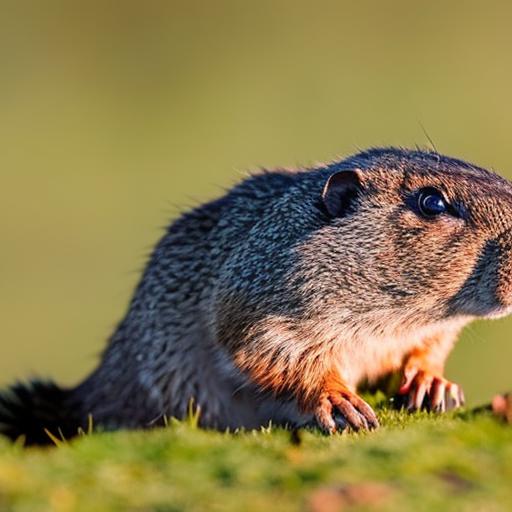Your cart is currently empty!

Where to Shoot a Groundhog with a .22: A Guide to Ethical Groundhog Hunting

Hey fellow hunters! If you’ve ever wondered “where to shoot a groundhog with a 22”, you’re in the right place. From the newbie with their first rifle to the seasoned pro, this guide has a little something for everyone.
Table of Contents
Groundhog Basics: Know Your Game
Let’s kick things off by getting acquainted with our burrow-dwelling friend, the groundhog. These critters, sometimes called woodchucks, typically weigh between 4 to 9 pounds, with a robust body covered in grizzled, grayish-brown fur. You’ll often spot them in meadows, woodlots, or on the edges of fields, where they’re most active during the day.
An interesting thing about groundhogs is their sunbathing habit. Yup, these creatures love to bask in the sun! You might find them lying flat out on a large rock, fence post, or even on the ground.
Fun fact: the same little buddy that predicts the coming of spring is also a gourmet! Groundhogs mainly feast on greens, fruits, and plants. But, if you’ve ever had one in your garden, you probably knew that already. They can wreak havoc on crops, which is why many of us are out there keeping their populations in check.

The .22 Rifle: Why It’s Perfect for Groundhogs
Now, onto the meat and potatoes: using a .22 for hunting groundhogs. I remember when my grandpa handed me my first .22 rifle. The lessons he taught me about the significance of choosing the right tool for the job stuck with me.
The .22 is both accurate and causes minimal meat damage, making it ideal for these critters. Plus, let’s face it, ammo won’t cost you an arm and a leg. There are different types of .22 ammunition, with hollow points being particularly effective for hunting.
Safety, as always, should be your top priority. Always treat a gun as if it’s loaded, keep it pointed in a safe direction, and only place your finger on the trigger when ready to shoot. Basic stuff, but worth repeating. Below I have tried to outline the pros and cons of .22 for groundhog and other small game hunting:
Pros:
- Accuracy and Precision: The .22 rifle, when used correctly, can offer a level of accuracy that’s unparalleled for small game hunting. I recall countless times when a well-placed shot with my trusty .22 ensured a quick and ethical kill, even from a significant distance.
- Cost-Efficiency: A definite advantage, especially for newcomers or those on a budget, is the affordability of .22 ammunition. With the ability to purchase rounds in bulk without breaking the bank, one can spend more time at the range honing their skills.
- Low Recoil: The minimal recoil of a .22 rifle makes it an excellent choice for beginners. It provides a less intimidating introduction to the world of shooting, allowing new hunters to focus on form, aim, and safety without the distraction of a heavy kick.
- Versatility: From squirrels to rabbits, and even groundhogs, the .22 can handle a variety of small game. Its versatility is perhaps one of the reasons I always ensure it’s part of my hunting repertoire.
- Quiet Operation: While not silent, the .22 is notably quieter than larger calibers. This reduced noise can be beneficial if you’re trying not to disturb other wildlife or if you’re hunting in areas where noise may be a concern.
Cons:
- Limited Stopping Power: The .22 caliber, while accurate, lacks the stopping power of larger rounds. This means the hunter must be particularly skilled and confident in their shot placement. An ill-placed shot could lead to unnecessary suffering for the animal, a scenario every ethical hunter strives to avoid.
- Not Suitable for Larger Game: Its name gives it away – the .22 is designed for small game. Attempting to take down larger animals can result in unethical outcomes. Throughout my years, I’ve seen novices make the mistake of overestimating the .22’s capabilities, leading to wounded animals and lost game.
- Wind Sensitivity: The lightweight .22 bullets are more susceptible to wind drift. Many a time, I’ve had to recalibrate my aim due to a sudden gust, or I’ve opted to wait for calmer conditions.
- Range Limitations: While the .22 rifle can be accurate, its effective range for hunting is limited. Longer shots require a better understanding of bullet drop and external ballistics.
- Over-Penetration Concerns: Despite its small size, a .22 bullet can still travel a considerable distance after passing through game. One always has to be cognizant of what’s behind their target. I’ve often chosen to pass on a shot because of uncertainty about where a bullet might end up.
Anatomy of a Groundhog: Understanding the Vital Zones
My dad always told me, “If you’re gonna do something, do it right.” That stuck with me, especially when it comes to hunting. To hunt ethically, you have to understand your game. Groundhogs are no different.
Know where to aim. The vital organs—heart, lungs, and brain—are your target. A clean shot to these areas ensures a quick, humane kill. Remember, the goal is to minimize suffering.

Best Shot Placements
Alright, let’s talk specifics on “where to shoot a groundhog with a 22”.
- Broadside shot: This is your go-to. Aim for the heart/lung area, which is right behind the front leg about one-third of the way up from the bottom of the body. I remember my first clean broadside shot; it was during a summer afternoon, and the satisfaction of knowing I made an ethical kill was unmatched.
- Headshot: A bit trickier due to the smaller target, but if you’re confident and close enough, it’s a surefire way for a quick kill. My buddy Jake swears by this shot, especially after that one time he nailed a groundhog from 50 yards out. Not everyone’s a Jake, but practice makes perfect.
- Quartering-away shot: The groundhog is slightly turned away from you. You’ll want to aim a tad further back to hit the vital organs. This shot requires understanding of angles, so take your time and make sure you’re confident.
Tips for Approaching and Stalking Groundhogs
Getting close enough for a shot can be an adventure in itself. Groundhogs have keen senses, so stealth is your best ally. Always approach from downwind. I can’t tell you how many times the wind gave me away before I caught on.
Utilize natural cover, like trees and bushes. Remember that sunny day I mentioned earlier? Shadows are your friend. Stay in them. And remember, patience isn’t just a virtue; it’s a necessity. Sometimes you’ll wait hours for the right shot. Embrace it.
Related Questions
- Can groundhogs be hunted year-round? Typically, no. Hunting seasons vary by state, so always check local regulations.
- What are some alternatives to hunting for controlling the population? Relocation and repellents can be effective, though not as long-term as hunting.
- Any restrictions on hunting groundhogs in specific areas? Again, check local regulations. Some states have specific laws regarding where and when you can hunt.
In wrapping things up, hunting groundhogs with a .22 is both a challenge and a thrill. Respect the animal, know your weapon, and always aim for a quick, humane kill. Whether it’s safeguarding crops or just enjoying a day outdoors, knowing “where to shoot a groundhog with a 22” ensures you’re doing it right. Happy hunting!

Herb has been a longtime lover of the outdoors. Whether it be hunting, camping, fishing or just getting outside to reset. Proud father and animal lover. Bourbon anyone?

by
Tags:
Comments
4 responses to “Where to Shoot a Groundhog with a .22: A Guide to Ethical Groundhog Hunting”
-
[…] hunters go on and on about shot placement, it’s because they’ve learned from experience. When hunting groundhogs with a pellet gun, you need to aim for the vital zones – typically the head or the heart-lung […]
-
[…] with this understanding, it becomes crucial to approach groundhog hunting with respect and ethics. Overhunting can disrupt the balance in local ecosystems and create an imbalance that affects other […]
-
[…] can I ensure an ethical kill when hunting groundhogs? Great question—ethics should always be a top priority. To ensure a humane kill, aim for the head […]
-
[…] Groundhog hunting can be both a challenge and a joy, with much of your success hinging on your choice of bait. A thorough understanding of the groundhog’s dietary preferences will ensure that you’re well-equipped to lure these critters effectively. […]

Categories
- Big Game Hunting (301)
- Deer (202)
- Reviews (3)
- Shooting (16)
- Slingshot (1)
- Small Game Hunting (42)
- Upland Hunting (126)
- Waterfowl Hunting (3)





Leave a Reply